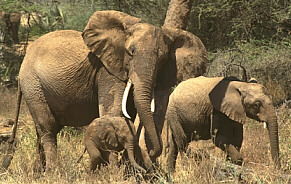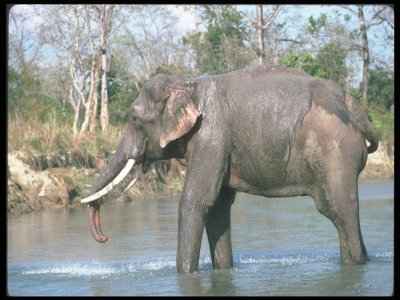| ELEPHANTS ON THE NET |
| IF ELEPHANTS RULED THE WORLD, WOULD THEY TREAT HUMANS AS BADLY AS HUMANS TREAT THEM? |

The elephant is an endangered species. The largest land animal alive today should not be allowed to disappear.
I use to take for granted that animals like the elephants would always be apart of the world. Now, some conservationists and wildlife biologists are saying that if the loss of habitat and killings for ivory continue, the elephant might be extinct in the wild by the early 2000's. If you care and have strong, positive feelings about the survival of Loxodonta Africana and Elephas Maximus, do what you can to save them from extinction. African Elephants (Loxodonta Africana) and Asian Elephants (Elephas Maximus) are the remaining two species of the ancient order of elephants. The immense size of the elephants have protected them from most predators with the exception of man. Poaching (Africa) and destruction of habitat (Asia) have caused the greatest harm to elephants. There has been a marked decline in poaching. This should allow the herds to increase somewhat in Africa. Destruction of habitat continues in Asia because of this continent's overpopulation problems. There has also been an increase in the loss of habitat and and migration routes in Africa's elephant country.
Interest shown by people worldwide may be the way to save them. As long as people want to see these magnificent animals in their native habitats in Asia and Africa and as long as folks continued to photograph them and study them, then the elephants have a real value. The value is not just for people of goodwill, but for the native inhabitants, who need to be shown that elephants can be of economic value to them. The value of tourism has and hopefully will continued to spur conservation of elephants in Asia and Africa.
| AFRICAN ELEPHANTS |

APPRECIATE THEIR MAGNIFICENCE
Look, Really See--Really Feel the Beauty, Elegance, Dignity and Passion of the African Elephant
The NOBLE AFRICAN ELEPHANT has not been treated well in Africa. They were not domesticated and trained and worshipped as in Asia. The Africans did not have much to supplement their diet with protein. So, they used the elephant for meat. The African Elephant, therefore, was seem as meat to be hunted and killed. Elephants lived among a human population that was often sparse. The elephants existence was unrestricted and not regulated by humans. Humans did not try to make many changes to the environment. Elephants stayed away from the human population, rarely moved about the humans' croplands and were not considered competition with livestock.
The AFRICAN PEOPLE, who had seen the elephant, did respect their strength, wisdom, and benevolence and power. The people did not attempt to have a close bond with an elephant. In the terrain in which elephants lived in Africa, elephants could not be used very often in epic battles or as working animals as they were used in Asia. The African Elephants are more difficult to train than the Asian Elephant. They are trainable, however, and have been used in zoos and in battles.
The MAJOR CAUSE of the lost of more than half of the elephant population in Africa is the massacre of elephants for the ivory trade. Between 1979 and 1989, the elephant population in Africa fell from 1.34 million to 625,000. In this ten year span, East Africa lost more than 52% of its elephant population. Kenya went from having about 130,000 to less than 17,000. Mature males were targeted more often due to the length of their tusks. Ivory trade has been suspended in most countries (legally), but is still carried on illegally. The residents in the villages in the African countries with elephant population, often see the elephant as a pest--ravaging their crops and and taking up valuable land that could be used for crops or habitation. Government officials, the military and the police are often corrupt and enable the export of ivory by means of false documents and looking the other way. Even if ivory loses its value, will the African people let the elephants proliferate is another question to be considered.
| ASIAN ELEPHANTS |

FASCINATING AND AMAZING
Symbol of Good Fortune--Worshipped and Honored, Sacred and Beloved--And Unique is the Asian Elephant
ASIAN ELEPHANTS--elephas maximus--differ from the African elephant in appearance, size and habitat. The Asian elephant has smaller ears, smaller tusks. The Asian male elephant has large visible tusks. The females have small tusks called tushes which are generally not visible. Asian elephants have two humps on the forehead and an arched back. Asian elephants have smoother skin than their African relatives. The Asian elephant has only one "finger" on the end of its trunk as compared with two "fingers" that the African elephant has on the end of its trunk.
AS FOR SIZE, the Asian elephant is smaller. Males stand 9 to 10 1/2 feet tall and weigh about 8000 pounds while females are shorter and weigh about 6,000 pounds.
THE HOME OF THE ASIAN ELEPHANT is in the forests and jungles of India, Sri Lanka, China, Indonesia, and southeast Asia. Estimates vary, but, there are approximately 29,000 to 50,000 Asian elephants still in the wild. Asian elephants are threatened more by destruction and fragmentation of their habitat rather than poaching (killing elephants for tusks) as is the African elephant. Almost 20% of the world's population lives in or near the range of Asian elephants. Elephant migratory routes have been disrupted by highways and urban development.
ASIAN ELEPHANTS often cannot find enough food in small forests for survival. Because of the overpopulation problems in places like India, elephants' feeding grounds have been converted to crop land to feed the ever-growing human population. Conflicts occur when the elephants look for the nearest source of food which is likely to be in the fields of the local farmers.
HUMANS USE ELEPHANTS AS WORK ANIMALS in Asia. Elephants log forests, transport heavy loads and carry tourists. Elephants can walk in areas where machinery can't navigate. Approximately 15,000 Asian elephants are held in captivity as work animals. Elephants seem be be held in a bit more of esteem in Asia than in Africa. They are important in Asian folklore and religion. They are believed to be cousins of the clouds and able to cause lightening
Elephant Facts
Click Above for Ellie Facts
| Favourite inks | |||||||
|
|
Email me on: |
|
This page has been visited
|
